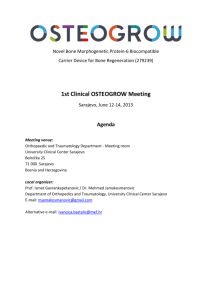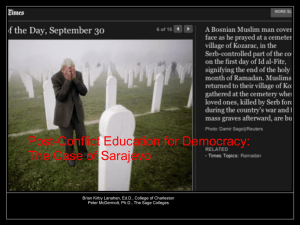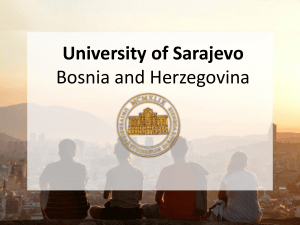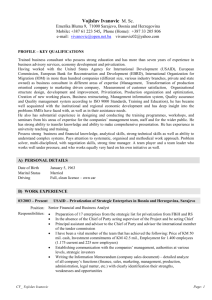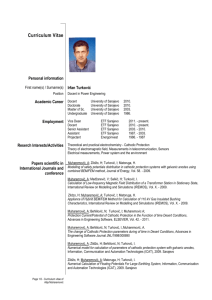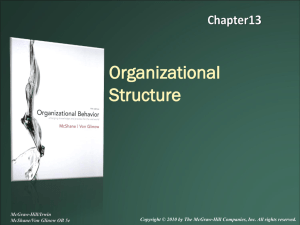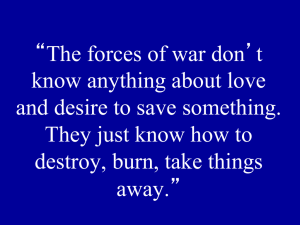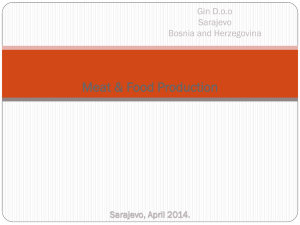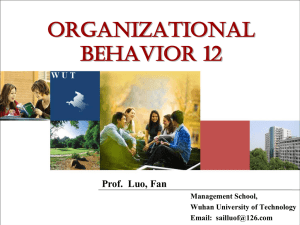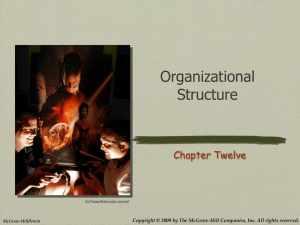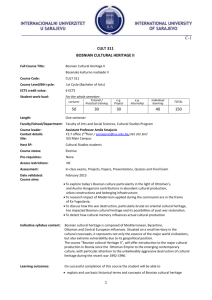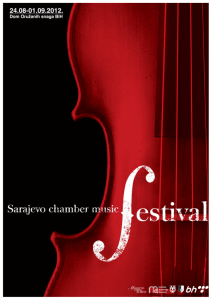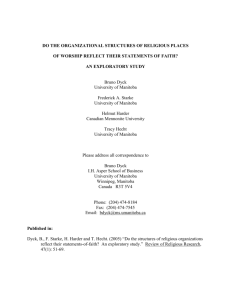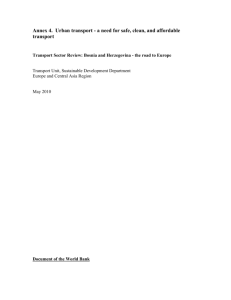positioned organized
advertisement
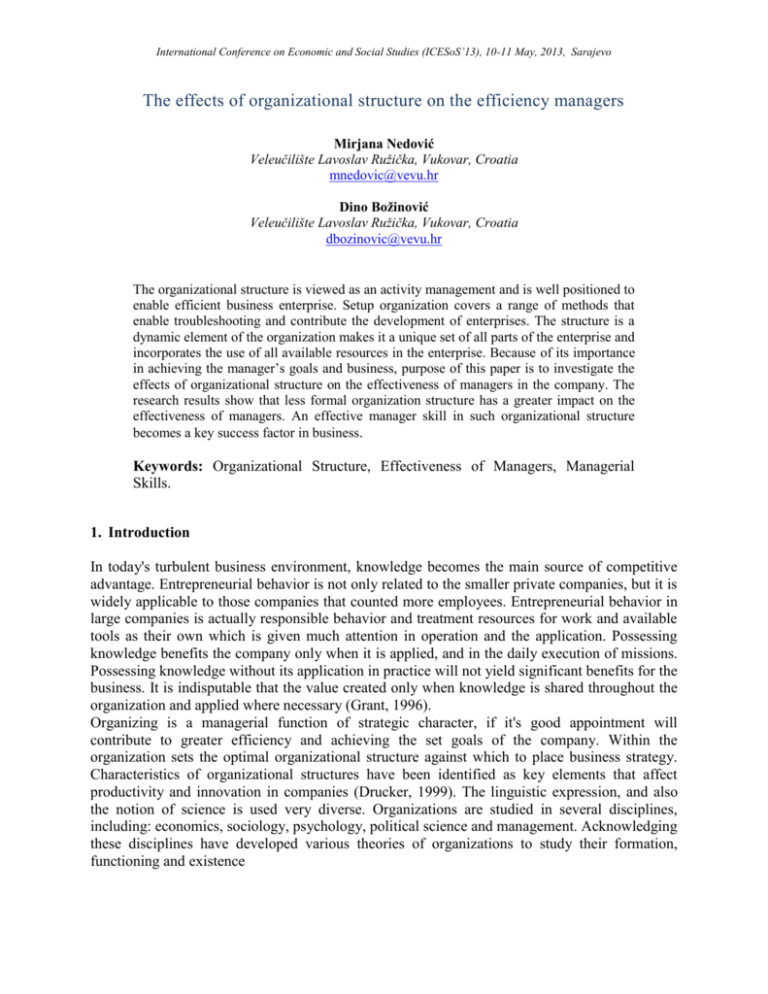
International Conference on Economic and Social Studies (ICESoS’13), 10-11 May, 2013, Sarajevo The effects of organizational structure on the efficiency managers Mirjana Nedović Veleučilište Lavoslav Ružička, Vukovar, Croatia mnedovic@vevu.hr Dino Božinović Veleučilište Lavoslav Ružička, Vukovar, Croatia dbozinovic@vevu.hr The organizational structure is viewed as an activity management and is well positioned to enable efficient business enterprise. Setup organization covers a range of methods that enable troubleshooting and contribute the development of enterprises. The structure is a dynamic element of the organization makes it a unique set of all parts of the enterprise and incorporates the use of all available resources in the enterprise. Because of its importance in achieving the manager’s goals and business, purpose of this paper is to investigate the effects of organizational structure on the effectiveness of managers in the company. The research results show that less formal organization structure has a greater impact on the effectiveness of managers. An effective manager skill in such organizational structure becomes a key success factor in business. Keywords: Organizational Structure, Effectiveness of Managers, Managerial Skills. 1. Introduction In today's turbulent business environment, knowledge becomes the main source of competitive advantage. Entrepreneurial behavior is not only related to the smaller private companies, but it is widely applicable to those companies that counted more employees. Entrepreneurial behavior in large companies is actually responsible behavior and treatment resources for work and available tools as their own which is given much attention in operation and the application. Possessing knowledge benefits the company only when it is applied, and in the daily execution of missions. Possessing knowledge without its application in practice will not yield significant benefits for the business. It is indisputable that the value created only when knowledge is shared throughout the organization and applied where necessary (Grant, 1996). Organizing is a managerial function of strategic character, if it's good appointment will contribute to greater efficiency and achieving the set goals of the company. Within the organization sets the optimal organizational structure against which to place business strategy. Characteristics of organizational structures have been identified as key elements that affect productivity and innovation in companies (Drucker, 1999). The linguistic expression, and also the notion of science is used very diverse. Organizations are studied in several disciplines, including: economics, sociology, psychology, political science and management. Acknowledging these disciplines have developed various theories of organizations to study their formation, functioning and existence International Conference on Economic and Social Studies (ICESoS’13), 10-11 May, 2013, Sarajevo Employee satisfaction in performing everyday tasks has a positive impact on business. In wellorganized set satisfied employees create a positive work environment. Such a positive environment and a sense of satisfaction will affect their higher productivity. Therefore, (Saeed et al., 2012) Employee satisfaction is a key to success of organization and operation, as well as the structure of the organization in which employees work affects their satisfaction and efficiency. The research in this paper seeks to answer the question whether there is a link between particular organizational structures with effective managers. 2. Organizing as a management function After defining the objectives and strategies selected to execute the objectives, it is necessary to form an effective organization as an instrument to achieve these goals. In this context, the organization manifests as activity management, which often occurs as the design and planning organizations (Buble, 2006, p 227). Design of a serious business and it is necessary to think over, and how to organize a company with low costs and increasing efficiency. The process of organizing is not easy as necessary to coordinate all existing organizational units that actually make the company. Project organization can be viewed as a process that establishes the ideal organizational structure, created authority managers, set tasks and responsibilities in order to better achieve company objectives. The process of establishing the organization must contain all of the essential components and solutions that would enable efficient business enterprise. According Kapustic (1984, pp. 77-83), the process of designing and establishing the organization knows two types of models, namely: 1. Linear decorated models that treat the process of organizing the time sequence and thus distinguish the recording phase of the existing situation, a critique of the existing situation, the proposal and implementation of new solutions and new control solutions. This procedure is commonly used in solving simple problems. 2. Cyclic decorated models are based on a system of solving complex problems in the organization. Their characteristics are established need for exploring the existing unsatisfactory situation and analyze problems, assess the possibilities of development and setting requirements, then the quantitative collection of information, relevant information at the stage of labor. The modern approach to the design of organizations based on the concept of project management and cyclically regulated model. Designing the application of methods required several methods that enable to solve problems and to contribute the development of the organization. These methods can be divided into two groups namely: general and specific. General methods are intended to solve the basic problems in the organization, at the thought of all those problems related to the organization as a homogeneous entity, and specific methods have a different purpose, which is to solve specific problems related to any distinct offense of which can be organizational unit or working place. International Conference on Economic and Social Studies (ICESoS’13), 10-11 May, 2013, Sarajevo 3. Features of organization The meaning of organization1 dates since the dawn of man and the history of human civilization, leading to the theory come to the realization that man is essentially from its inception knows and understands the concept of its importance and significance. Man their problems, working and / or living together solves organized with other people, which means that a man all his life carried in a sort of whether the educational institutions such as schools or colleges or to an organization in which a man spends his free time such as sports organizations, charities, political, and many others. Individual human being in any type of organization operates, and directly or indirectly contributes to the development. Let's just the fact that the active population, that most adults, daily carried about a third of the time in the organizations in which it operates (Žugaj et.al., 2004). You could never, and cannot now live without the organization, that man is constantly connected to the organization because it essentially ensures the existence and prosperity of the world that surrounds him. Therefore, man actually always has been adept at organizing. The organization has developed in proportion to the development of productive forces, which followed a certain socio-economic trends. The organization of the future development of socio-economic and industrial factors multiplied in various forms, significantly increasing the number of organizations until she took today's proportions. The meaning of the foreground is reflected in the kind man benefits from the organization in any area of his life and work. Man achieves its objectives and tasks through organization. Therefore the organization is expanding the volume of individual human power because it forces the individual creates social force. Today we can no longer talk about only the organization but rather on a useful and effective organization for the development of new information technologies and technological processes and provides enormous opportunities in the development, improvement of the working and living both in economic and in all areas of activity Sometimes the organization man imposes duties which are not in accordance with his mentalphysical abilities or opposes his idea of work, and thus harms the human body as mentally and physically. Therefore, we can say that a man in such organization in most cases feel degraded and alienated from himself and the conditions and results of their work. So any association or establish certain connections and relationships with other people, restricts freedom of behavior (Žugaj et al., 2004). But to find someone to opinions and to confront the organization crazy idea and that the false claims about how a man loses his individuality as a member of strengthening its personality and it certainly comes to the fore. 1 Organization (latin organisation) bonding, structure, unification of something in one unit, bringing the regulated system (Klaić, 1986) International Conference on Economic and Social Studies (ICESoS’13), 10-11 May, 2013, Sarajevo 5. Organization structure The organizational structure2 represents relationship between factors of production, and the relations within these factors. This is the most important part of any organization. These relations are established to carry out specific tasks. Also represent organizational resources schedule. Significant place in the organizational theory holds exploration of organizational structures for the simple reason that the structure is very important in every organization. Numerous scholars both foreign and domestic have developed several theories of organizational structure. Diversity of defining the organizational structure resulting from different approaches conceptualizing. Sikavica (1999, p 142) states that the organizational structure involves the totality of connections and relationships between all the factors of production, as well as the totality of connections and relationships within each factor of production or operations. The organizational structure is usually categorized in three dimensions: formalization, centralization and integration (Andrews, 2001); Formalizing a significant dimension of the organizational structure, and is associated with the complexity of the organization. It refers to the degree of prescription, the level of standards and measures of employee behavior in accordance with the prescribed rules and procedures. In organizations where there is a high degree of formalization, prescribed the correct rules and procedures. In organizations with low formalization, job behaviors are relatively Unstructured and members have greater freedom in dealing with the demands of their relevant tasks (Sivadas, 2000). Centralization refers to the locus of decision-making authority lying in the higher levels of a hierarchical relationship (Tsai, 2002). Centralization creates a non-participatory environment that reduces communication, commitment, and involvement with tasks and projects among participants (Sivadas and Dwyer, 2000). Valid answers to these questions can be recognized as an organization is centralized or decentralized (Sikavica, 1999): What is the number of decisions to be made at lower levels? A large number of decision points to greater decentralization. What is the importance of the decisions that are made at lower levels? If these are important decisions, then it is a significant decentralization and vice versa. What is the impact of decisions to be made at lower levels? Little or no effect indicates a greater centralization of decision-making. How often subordinated levels checked by senior management? Integration refers to the extent to which various subdivisions of an organization work interrelated (Sciulli, 1998). Employees in the organization should be able to have access to the 2 Structure (lat. structura) method of construction, composition (Anic, 2002). International Conference on Economic and Social Studies (ICESoS’13), 10-11 May, 2013, Sarajevo broadest variety of knowledge for work and problem solving. Integrative work structure provides opportunities for employees to learn from their colleagues (Chung-Jen & Jing-Wen, 2007). In accordance with overall criteria parsing tasks, identified two types of organizational structure, functional and division. Functional organizational structure is focus on the tasks, business functions, while divisional organizational structure focuses on the product or service and is a consequence of the complexity of operations, (Sikavica and Novak, 1999, p 167). 6. Elements of organizational structure The organizational structure includes elements between which there are connections and relationships. These connections and relationships are an important component of these structures and these include (Žugaj et.al., 2004): organization of the means of production and rational arrangement of space, organization of human resources, parsing tasks until details, organization and internal affairs, determine the temporal sequence of operations. The first element of the organizational structure of the organization includes the means of production as in the former theory and practice was not the case on the grounds that these funds are sometimes not changed so often. In the past, an element of the means of production was considered a necessary condition for the establishment of the organization in general and without them could join the organization. But today, the presence of more and more automation of business resources for the production of ''transformed'' from once only technical variables to the basic element of the organizational structure. It is also an essential component of the elements of the organization makes use and management of equipment. Equipment basically makes fixed assets for the business. Activity of the individual companies engaged largely influence the decision on the purchase of equipment, thus the selection and purchase of equipment becomes an organizational problem. Since we live in an age of high technology development in various companies, which increasingly is the case comes to automation of business and is therefore a more sensitive and expensive equipment and make any inappropriate handling of it could greatly affect the final result of the business. Then, very important element in the organizational structure is organization of human resources. This refers to the working atmosphere in the company, division and redistribution of tasks, structure and integration of the collective and all the problems that arise from these, such as motives, frustration, passion for work, training, etc. Human Resources Management now has a significant role in the organization of the company. It manifests itself on the one hand the involvement of managers in the implementation of personnel management functions, on the other hand the position of specific organizational units (departments) who are professionally engaged in human affairs (Buble, 2006). To the company existed and successfully fulfilled their tasks and economic objectives must be employees, as long as people participate actively in the company the means of production are a passive participant in the production. But the fundamental problem that occurs in every company is how to establish a successful organization of human resources in a way to satisfy the common and personal interests. This is the main problem for the entire collective work is needed systematization of jobs that will define and describe in detail all the tasks and the expected goals of the individual employee at the specific International Conference on Economic and Social Studies (ICESoS’13), 10-11 May, 2013, Sarajevo workplace that is conducted systematization. A certain group of people then it becomes work collectives mutually dependent or independently perform tasks and thus contribute to the betterment of their business. Also working collective is a unique organization with a common purpose and morality as well as the individual realizes his personal desires, needs and goals. Redistribution of the entire task to the individual and specific tasks makes it the third element of the organizational structure, but the reallocation of tasks to specific and individual belong also mutual sharing. This includes the organization of jobs, the organization functions in the economic entity, the determination of organizational units in carrying out specific tasks or individual. Analyze the entire task on a specific organization that will enable perfect execution of tasks, which can be achieved by establishing the specific functions of the company. Business function of a set of related activities is most useful to perform special task enterprises (Žugaj et al., 2004). For definitions of business functions essential component of this is that it is a mutually working operation. Basic classification of functions of the company is: market research, development function, purchase, sales, production, personnel, and accounting. The fourth element of the organizational structure deals with the problem of internal relations management and leadership and management. Since management is the process of managing resources more efficiently and effectively, only managing executive activity that focuses on the achievement of pre-planned targets. Element that ensures the orderly and timely execution of specific tasks is to determine the temporal sequence of operations which is the fifth element of the organizational structure. It is done with the help of technical and organizational resources such as scheduling to achieve the ultimate goal of tasks (fig. 1). Figure 1: Presentation of the organizational structure of enterprises The organization of the means of production Organization timing of operations The organization of human resources Organization of internal relations Breakdown of tasks Source: created authors 7. Research and analysis of results The study was conducted by a staff questionnaire. The questionnaire was sent by e-mail on behalf of employees who are in management positions (middle management) into fifteen International Conference on Economic and Social Studies (ICESoS’13), 10-11 May, 2013, Sarajevo companies X3. The questionnaire consisted of three parts. The first part consisted of six questions regarding the formalization of enterprises. The second section consisted of two questions related to the integration of companies; the third unit consisted of two questions related to the centralization of business. Respondents had to answer the questions and answer, "I agree" or "disagree". Questions Answered "agree" are combined and presented in absolute and relative numbers (Table 1) Table 1: Measuring organizational structure Organization structure Respondents n =15 Formalization The company provides a number of rules, procedures and policies Prescribed procedures are useful and appropriate Execution of tasks on a daily supervised Decisions taken important decisions Adopted decisions have a major impact on business The flow of information is quick and accessible Integration The company is vertically integrated The company is horizontal integrated Centralization Autonomy in the area of work is large Feel free to propose new ideas and solutions for the process is welcome Agree (%) Disagree (%) 14 (90%) 1 (10%) 9 (60%) 6 (40%) 9 (60%) 6 (40%) 3 (20%) 12 (80%) 4 (27%) 11 (73%) 10 (67%) 5 (33%) 7 (47%) 8 (53%) 8 (53%) 7 (47%) 12 (80%) 3 (20%) 13 (87%) 2 (13%) Source: own research The results showed that the company actually observed a highly formalized, and 90% of employees believe that there are a number of rules, procedures and policies, and conversely only 10% of employees believe that the company is highly formalized. 60% of employees are satisfied with the prescribed procedures, while only 6% are not satisfied 3 X - indicates observed companies because not permitted taking names in this paper International Conference on Economic and Social Studies (ICESoS’13), 10-11 May, 2013, Sarajevo with the same. A small number of employees (20%) think that makes important decisions, while 80% of employees think that senior management makes the decision. A large number of employees is of the opinion that the rapid flow of information and available (67%), while fewer believe that the information could be made available (33%). When asked about the integration of companies noted that employees do not really differ that the company integrated vertically or horizontally so that the results show that 47% of employees believe that their company is vertically integrated, and 53% of employees believe that the company is integrated horizontally. 80% of respondents believe that managers have autonomy in their work, while only 20% believe that there is. When asked if they could free their ideas for business processes as much as 83% answered in the affirmative, while only 13% think they do not have that option. Looking at the results it can be concluded that the company highly formalized, however, employees are satisfied with the prescribed procedures and there is a great autonomy in business and freedom to propose their own ideas for the improvement of all processes which results in good business results observed companies. Stepping senior management should be in the direction of middle management authority to make decisions of great importance for the company that will transcend organizational unit of middle management and have a greater impact on the overall business. It can be assumed that placing the less formal organization have a positive incentive to managers in terms of even greater freedom to propose new ideas and solutions to existing problems in business. Managers need to create a sense that their proposals are important for the entire company and all operations, which will boost their efficiency and increase a sense of importance in a hierarchical structure. 8. Findings The structure of the company is laying the groundwork of its proper functioning. Good set structure is a task manager that is, a level of managerial control. The structure is composed of several elements that are interconnected and should work harmoniously in terms of achieving greater efficiency and effectiveness. Without employee cannot be done any work assignments, same as their right organization where every employee knows his role. This is the basis of good appointment structure. The organization can be set up as a more or less formal, depending on the intensity of structuring; in fact it can be viewed in three dimensions: formalization, centralization and integration. Results of research carried out in this paper indicate that less formal organization affects the greater efficiency of managers and actually encourages their creative side of thinking about the tasks at work. Sam importance and it actually makes the organizational structure should be well understood managerial employees at all hierarchical levels to actually better understand their role in the company, but also the expectations of their superiors. Middle management needs to create a sense that their decisions are important for the whole company, or to have a significant impact on the overall business. In this context, the results of their operations will then be successful. Setting the organization includes a number of methods that contribute to a better development of enterprises, and before International Conference on Economic and Social Studies (ICESoS’13), 10-11 May, 2013, Sarajevo its setting should be studied in detail all the factors, and eventually upgraded and changed in response to changes in the environment. References Andrews, M. C., & Kammar, K. M. (2001). Discriminating among organizational politics, justice, and support. Journal of Organizational, 22, p. 347-366. Buble, M. (2006). Menadžment. Split. Chung-Jen, C., & Jing-Wen, H. (2007). How organizational climate and structure affect knowledge. International Journal of Information Management, 27, p. 104-118. Drucker, P. (1999). Management challenges for 21 century. New York: Harper Collins. Grant, R. M. (1996). Toward a knowledge-based theory of the firm. Strategic Management Journa , 17, p. 109-122. Klaić, B. (1986). Rječnik starnih riječi A-Z. Zagreb: Grafički zavod hrvatske. Saeed, R., Arbabisarjou, A., Zivarirahman, M., & Shokouhi, S. (2012). Relationship between Organizational Structure and Organizational. Interdisciplinary Journal of Contemporary Research In Business (12), p. 188-196. Sciulli, L. M. (1998). How organizational structure influences success in various types of innovation. Journal of Retail Banking Services, p. 13-18. Sikavica, P., & Novak, M. (1999). Poslovna organizacija. Zagreb: Informator. Sivadas, E., & Dwyer, F. R. (2000). An examination of organizational factors influencing new product success in internal and alliancebased. Journal of Marketing, 64, p. 31-50. Tsai, W. (2002). Social structure of ‘‘coopetition’’ within a multiunit organization: Coordination, competition, and intra-organizational. Organization Science, 13, p. 179-190. Žugaj, M., Šehanović, J., & Cingula, M. (2004). Organizacija. Varaždin.
